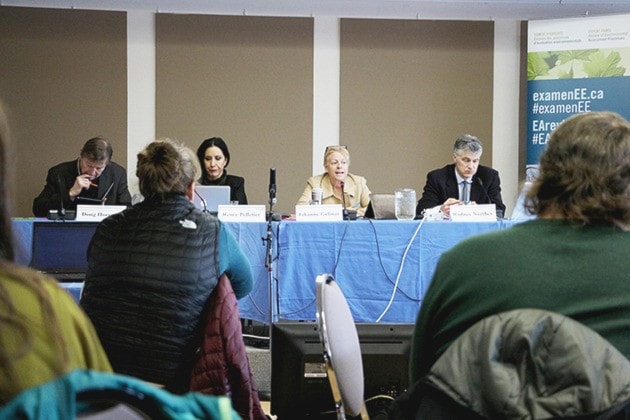Complaints about and suggestions to improve how a federal agency reviews major project proposals were heard in Prince Rupert for two days this month.
A federally-appointed panel listened to industry stakeholders, as well as indigenous and conservation groups comment on how the Canadian Environmental Assessment Agency (CEAA) considers environmental and other impacts of projects such as the Pacific NorthWest LNG plant contemplated for Lelu Island.
The panel began public consultations in September with Prince Rupert being one of its last stops.
The Tsimshian Environmental Stewardship Authority’s environmental assessment manager, James Witzke, spoke of lack of consideration of socio-economic impacts both on and off reserve communities, lack of an adequate long-term environmental monitoring process and a lack of adequate cumulative effects assessment or management.
Prince Rupert Port Authority’s director of environmental planning, Jack Smith, stated that “during the assessment of project impacts, we believe that the current federal legislation is an effective guide to community consultation and consideration of environmental factor.”
However, he said that environmental assessments should be timely and predictable with clear objectives for the responsible authorities involved.
But Nikki Skuce from the Northern Confluence Initiative based in Smithers said there was a lack of public confidence.
“In the past, there used to be a link when an authorization is required under the Fisheries Act that would trigger a federal environmental assessment, (after the 2012 changes to the CEAA) it no longer does and we want that back. So that fisheries, fish and fish habitat is a trigger for an environmental assessment with the CEAA,” Skuce said.
An organization from Alaska was also present. Jill Weitz, manager of Salmon Beyond Borders, said there needs to be more federal engagement in projects that have trans-boundary implications.
There are three watersheds that border southeast Alaska and northwest B.C., the Taku, Stikine and Unuk Rivers north of the Nass and Skeena rivers. Within those watersheds, there are more than 10 large scale mines at different stages of development.
“Currently, we have no meaningful stake or seat at the table. The State of Alaska has worked with B.C. in the last year to essentially create this statement of cooperation, which is a good first step but does not give enforceable protections. They don’t have the authority to establish those and enforce those,” Weitz said.
For projects that have trans-boundary implications, between provinces and international boundaries, Weitz said the environmental review should be federal and not provincial.
Her concerns elevated after reading the B.C. Auditor General’s report in 2016 that suggested compliance and enforcement in the mining industry is failing, she said it’s clear the province is not doing its job.
“We are desperately looking for solutions because this is a forward-looking exercise,” said panel chair Johanne Gélinas.
Shannon Lough is a reporter with The Northern View in Prince Rupert.
